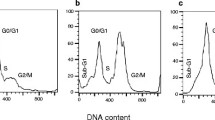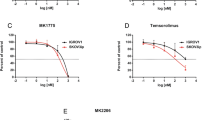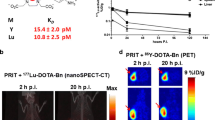Abstract
Purpose
The L1 cell adhesion molecule (L1CAM) is considered a valuable target for therapeutic intervention in different types of cancer. Recent studies have shown that anti-L1CAM radioimmunotherapy (RIT) with 67Cu- and 177Lu-labelled internalising monoclonal antibody (mAb) chCE7 was effective in the treatment of human ovarian cancer xenografts. In this study, we directly compared the therapeutic efficacy of anti-L1CAM RIT against human ovarian cancer under equitoxic conditions with the radiolanthanide 177Lu and the potential alternative 161Tb in an ovarian cancer therapy model.
Methods
Tb was produced by neutron bombardment of enriched 160Gd targets. 161Tb and 177Lu were used for radiolabelling of DOTA-conjugated antibodies. The in vivo behaviour of the radioimmunoconjugates (RICs) was assessed in IGROV1 tumour-bearing nude mice using biodistribution experiments and SPECT/CT imaging. After ascertaining the maximal tolerated doses (MTD) the therapeutic impact of 50 % MTD of 177Lu- and 161Tb-DOTA-chCE7 was evaluated in groups of ten mice by monitoring the tumour size of subcutaneous IGROV1 tumours.
Results
The average number of DOTA ligands per antibody was 2.5 and maximum specific activities of 600 MBq/mg were achieved under identical radiolabelling conditions. RICs were stable in human plasma for at least 48 h. 177Lu- and 161Tb-DOTA-chCE7 showed high tumour uptake (37.8–39.0 %IA/g, 144 h p.i.) with low levels in off-target organs. SPECT/CT images confirmed the biodistribution data. 161Tb-labelled chCE7 revealed a higher radiotoxicity in nude mice (MTD: 10 MBq) than the 177Lu-labelled counterpart (MTD: 12 MBq). In a comparative therapy study with equitoxic doses, tumour growth inhibition was better by 82.6 % for the 161Tb-DOTA-chCE7 than the 177Lu-DOTA-chCE7 RIT.
Conclusions
Our study is the first to show that anti-L1CAM 161Tb RIT is more effective compared to 177Lu RIT in ovarian cancer xenografts. These results suggest that 161Tb is a promising candidate for future clinical applications in combination with internalising antibodies.



Similar content being viewed by others
References
Yap TA, Carden CP, Kaye SB. Beyond chemotherapy: targeted therapies in ovarian cancer. Nat Rev Cancer. 2009;9:167–81.
Bukowski RM, Ozols RF, Markman M. The management of recurrent ovarian cancer. Semin Oncol. 2007;34:S1–15.
Hirte HW. Profile of erlotinib and its potential in the treatment of advanced ovarian carcinoma. Onco Targets Ther. 2013;6:427–35.
Schilder RJ, Sill MW, Lee RB, Shaw TJ, Senterman MK, Klein-Szanto AJ, et al. Phase ii evaluation of imatinib mesylate in the treatment of recurrent or persistent epithelial ovarian or primary peritoneal carcinoma: a gynecologic oncology group study. J Clin Oncol. 2008;26:3418–25.
Raveh S, Gavert N, Ben-Ze’ev A. L1 cell adhesion molecule (L1CAM) in invasive tumors. Cancer Lett. 2009;282:137–45.
Weidle UH, Eggle D, Klostermann S. L1-CAM as a target for treatment of cancer with monoclonal antibodies. Anticancer Res. 2009;29:4919–31.
Kiefel H, Bondong S, Hazin J, Ridinger J, Schirmer U, Riedle S, et al. L1CAM a major driver for tumor cell invasion and motility. Cell Adhes Migr. 2012;6:374–84.
Gavert N, Ben-Shmuel A, Raveh S, Ben-Ze’ev A. L1-CAM in cancerous tissues. Expert Opin Biol Ther. 2008;8:1749–57.
Novak-Hofer I. The L1 cell adhesion molecule as a target for radioimmunotherapy. Cancer Biother Radiopharm. 2007;22:175–84.
Boo YJ, Park JM, Kim J, Chae YS, Min BW, Um JW, et al. L1 expression as a marker for poor prognosis, tumor progression, and short survival in patients with colorectal cancer. Ann Surg Oncol. 2007;14:1703–11.
Fogel M, Gutwein P, Mechtersheimer S, Riedle S, Stoeck A, Smirnov A, et al. L1 expression as a predictor of progression and survival in patients with uterine and ovarian carcinomas. Lancet. 2003;362:869–75.
Kaifi JT, Reichelt U, Quaas A, Schurr PG, Wachowiak R, Yekebas EF, et al. L1 is associated with micrometastatic spread and poor outcome in colorectal cancer. Mod Pathol. 2007;20:1183–90.
Huszar M, Moldenhauer G, Gschwend V, Ben-Arie A, Altevogt P, Fogel M. Expression profile analysis in multiple human tumors identifies L1 (CD171) as a molecular marker for differential diagnosis and targeted therapy. Hum Pathol. 2006;37:1000–8.
Arlt MJE, Novak-Hofer I, Gast D, Gschwend V, Moldenhauer G, Grünberg J, et al. Efficient inhibition of intra-peritoneal tumor growth and dissemination of human ovarian carcinoma cells in nude mice by anti-L1-cell adhesion molecule monoclonal antibody treatment. Cancer Res. 2006;66:936–43.
Fischer E, Grünberg J, Cohrs S, Hohn A, Waldner-Knogler K, Jeger S, et al. L1-CAM-targeted antibody therapy and 177Lu-radioimmunotherapy of disseminated ovarian cancer. Int J Cancer. 2012;130:2715–21.
Knogler K, Grünberg J, Zimmermann K, Cohrs S, Honer M, Ametamey S, et al. Copper-67 radioimmunotherapy and growth inhibition by anti-L1-cell adhesion molecule monoclonal antibodies in a therapy model of ovarian cancer metastasis. Clin Cancer Res. 2007;13:603–11.
Wolterink S, Moldenhauer G, Fogel M, Kiefel H, Pfeifer M, Luttgau S, et al. Therapeutic antibodies to human L1CAM: functional characterization and application in a mouse model for ovarian carcinoma. Cancer Res. 2010;70:2504–15.
Friedli A, Fischer E, Novak-Hofer I, Cohrs S, Ballmer-Hofer K, Schubiger PA, et al. The soluble form of the cancer-associated L1 cell adhesion molecule is a pro-angiogenic factor. Int J Biochem Cell Biol. 2009;41:1572–80.
Novak-Hofer I, Amstutz HP, Morgenthaler JJ, Schubiger PA. Internalization and degradation of monoclonal-antibody chCE7 by human neuroblastoma-cells. Int J Cancer. 1994;57:427–32.
Lehenberger S, Barkhausen C, Cohrs S, Fischer E, Grünberg J, Hohn A, et al. The low-energy beta(-) and electron emitter Tb-161 as an alternative to Lu-177 for targeted radionuclide therapy. Nucl Med Biol. 2011;38:917–24.
Grünberg J, Novak-Hofer I, Honer M, Zimmermann K, Knogler K, Bläuenstein P, et al. In vivo evaluation of Lu-177- and Cu-67/64-labelled recombinant fragments of antibody chCE7 for radioimmunotherapy and PET imaging of L1-CAM-positive tumors. Clin Cancer Res. 2005;11:5112–20.
Lindmo T, Boven E, Cuttitta F, Fedorko J, Bunn PA. Determination of the immunoreactive fraction of radiolabeled monoclonal-antibodies by linear extrapolation to binding at infinite antigen excess. J Immunol Methods. 1984;72:77–89.
Foltz CJ, Ullman-Cullere M. Guidelines for assessing the health and condition of mice. Lab Anim. 1999;28:28–32.
Shannon RD. Revised effective ionic-radii and systematic studies of interatomic distances in halides and chalcogenides. Acta Crystallogr A. 1976;32:751–67.
Viola-Villegas N, Doyle RP. The coordination chemistry of 1,4,7,10-tetraazacyclododecane-n, n′, n″, n′″-tetraacetic acid (h(4)DOTA): structural overview and analyses on structure-stability relationships. Coord Chem Rev. 2009;253:1906–25.
Corneillie TM, Whetstone PA, Fisher AJ, Meares CF. A rare earth-DOTA-binding antibody: probe properties and binding affinity across the lanthanide series. J Am Chem Soc. 2003;125:3436–7.
Reddy N, Ong GL, Behr TM, Sharkey RM, Goldenberg DM, Mattes MJ. Rapid blood clearance of mouse IgG2a and human IgG1 in many nude and nu/+mouse strains is due to low IgG2a serum concentrations. Cancer Immunol Immunother. 1998;46:25–33.
van Gog FB, Brakenhoff RH, Snow GB, van Dongen G. Rapid elimination of mouse/human chimeric monoclonal antibodies in nude mice. Cancer Immunol Immunother. 1997;44:103–11.
Brouwers AH, van Eerd JE, Oosterwijk E, Oyen WJ, Corstens FH, Boerman OC. Preparation, characterization and application of I-131, Re-186, Y-90 and Lu-177-labeled cG250 for radioimmunotherapy of renal cell carcinoma. J Nucl Med. 2002;43:268P–9.
Kassis AI. The amazing world of Auger electrons. Int J Radiat Biol. 2004;80:789–803.
Pouget JP, Santoro L, Raymond L, Chouin N, Bardies M, Bascoul-Mollevi C, et al. Cell membrane is a more sensitive target than cytoplasm to dense ionization produced by Auger electrons. Radiat Res. 2008;170:192–200.
Behr TM, Behe M, Lohr M, Sgouros G, Angerstein C, Wehrmann E, et al. Therapeutic advantages of Auger electron- over beta-emitting radiometals or radioiodine when conjugated to internalizing antibodies. Eur J Nucl Med. 2000;27:753–65.
Paillas S, Boudousq V, Piron B, Kersual N, Bardies M, Chouin N, et al. Apoptosis and p53 are not involved in the anti-tumor efficacy of I-125-labeled monoclonal antibodies targeting the cell membrane. Nucl Med Biol. 2013;40:471–80.
Boswell CA, Brechbiel MW. Auger electrons: lethal, low energy, and coming soon to a tumor cell nucleus near you. J Nucl Med. 2005;46:1946–7.
Kassis AI. Molecular and cellular radiobiological effects of Auger emitting radionuclides. Radiat Prot Dosim. 2011;143:241–7.
Buchegger F, Perillo-Adamer F, Dupertuis YM, Delaloye AB. Auger radiation targeted into DNA: a therapy perspective. Eur J Nucl Med Mol Imaging. 2006;33:1352–63.
Chen P, Wang J, Hope K, Jin LQ, Dick J, Camron R, et al. Nuclear localizing sequences promote nuclear translocation and enhance the radiotoxicity of the anti-CD33 monoclonal antibody hum195 labeled with In-111 in human myeloid leukemia cells. J Nucl Med. 2006;47:827–36.
Costantini DL, Chan C, Cai ZL, Vallis KA, Reilly RM. In-111-labeled trastuzumab (herceptin) modified with nuclear localization sequences (nls): an Auger electron-emitting radiotherapeutic agent for her2/neu-amplified breast cancer. J Nucl Med. 2007;48:1357–68.
Guo YJ, Parry JJ, Laforest R, Rogers BE, Anderson CJ. The role of p53 in combination radioimmunotherapy with Cu-64-DOTA-cetuximab and cisplatin in a mouse model of colorectal cancer. J Nucl Med. 2013;54:1621–9.
Boyd M, Ross SC, Dorrens J, Fullerton NE, Tan KW, Zalutsky MR, et al. Radiation-induced biologic bystander effect elicited in vitro by targeted radiopharmaceuticals labeled with alpha-, beta-, and Auger electron-emitting radionuclides. J Nucl Med. 2006;47:1007–15.
Acknowledgments
This work was supported by the Swiss Cancer Research Foundation (Project No. KFS-2546-02-2010) to Jürgen Grünberg
Conflict of interest
None
Author information
Authors and Affiliations
Corresponding author
Electronic supplementary material
Below is the link to the electronic supplementary material.
ESM 1
(DOC 1391 kb)
Rights and permissions
About this article
Cite this article
Grünberg, J., Lindenblatt, D., Dorrer, H. et al. Anti-L1CAM radioimmunotherapy is more effective with the radiolanthanide terbium-161 compared to lutetium-177 in an ovarian cancer model. Eur J Nucl Med Mol Imaging 41, 1907–1915 (2014). https://doi.org/10.1007/s00259-014-2798-3
Received:
Accepted:
Published:
Issue Date:
DOI: https://doi.org/10.1007/s00259-014-2798-3




